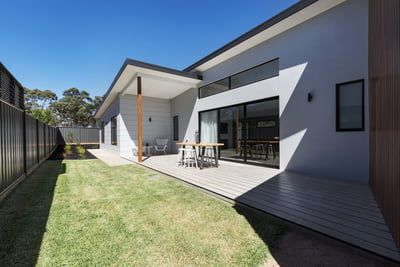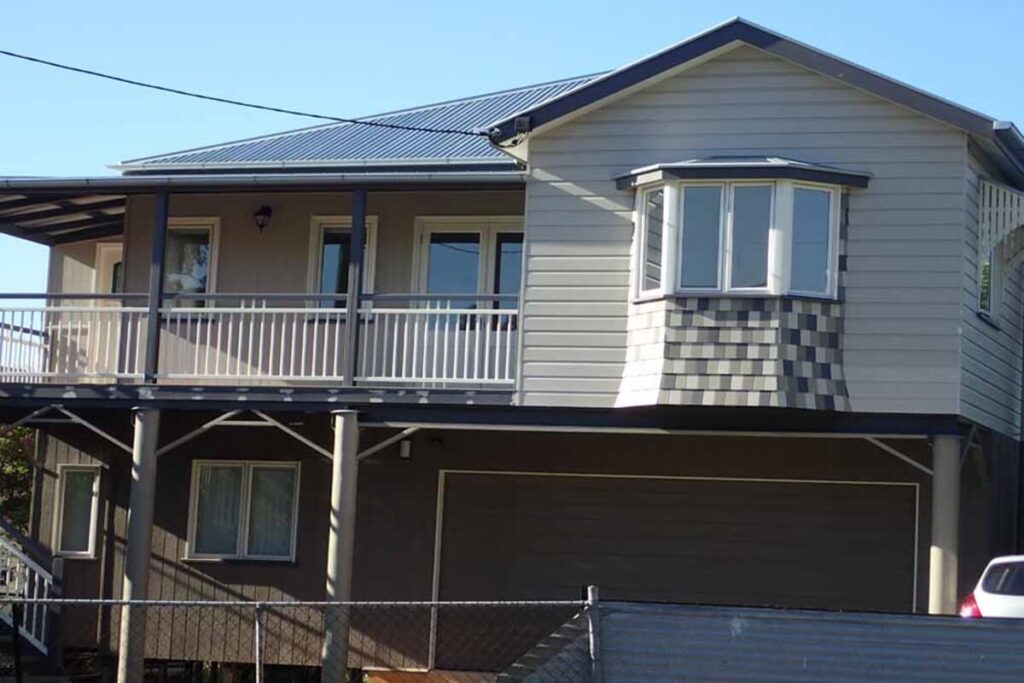Buying or own property in Brisbane and considering renovating? There is a fair chance the house will contain fibre cement cladding, either externally or internally. A fibre cement cladding inspection will identify any problems with the fibre cement sheeting before you expose yourself to what could be a costly and/or potentially hazardous situation. Here is what you need to know about fibre cement cladding:
When it comes to choosing building materials for the external façade of your house, fibre cement cladding has a lot going for it. Not only is it versatile and looks great, but it’s also asbestos-free, weather-proof and resistant to termites. Pretty impressive as far as building materials go, right?!
Fibre Cement Cladding is Not Fail-Proof
If you’re planning to invest in a home with fibre cement cladding, you may question the need for a pre-purchase building inspection. But, be warned – no building material is fail-proof. Building and pest inspectors can find issues with fibre cement cladding during an inspection. Read on to find out why.
What is fibre cement cladding?
First things first, what exactly is fibre cement cladding? Fibre Reinforced Cement or fibre cement is a building material developed in the early 1980s. James Hardie developed the material as an alternative to the building materials on offer at the time. The aim was to deliver to the market a cement-based product that was free of asbestos. Fibre cement is made from sand, cement and cellulose fibres.
Fibre cement cladding is a popular choice for builders because it is simple to install and brings with it a host of benefits. It is weather-proof and resistant to water. This means you don’t have to contend with rot or warp as a result of weathering or water damage. If that wasn’t enough, fibre cement cladding installed correctly works as an effective termite barrier. It can help keep your house cool on warm days and is a low maintenance material.
What is fibre cement cladding used for?
Fibre cement cladding is used particularly in areas that may be subject to either high fire danger and/or wet conditions. When used on the exterior of a home it is often found used as eave linings, fascias and barge boards, however it can also be used to cover the exterior of buildings in either sheet form “fibro” or as “hardie board planks”. Your building inspector will identify where fibre cement cladding has been used.
Problems with fibre cement cladding
Found a home with fibre cement cladding and you just have to have it? If you think you can pass on a building and pest inspection because you’re investing in a fibre cement cladded home, think again. Don’t be fooled into thinking that the home will be free of structural issues, pest problems or weather and water damage.
It may be built to withstand weather, water and termites, but fibre cement cladding isn’t fool proof. If the fibre cement cladding on your potential buy has not been installed properly or maintained to the correct standard, issues can arise. These issues have the potential to be serious and costly, if not addressed.
External cladding that is ill-fitted or poorly structured could expose your home to the elements. The last thing you want is water coming into your home every time it rains or storms, not to mention the damage that could have already been caused from a gap in the cladding.
Leaks can cause serious issues to the structure of your home, including warping and rot of framework. Water stains and mould are another issue you don’t want to have to contend with. Gaps in the external cladding can also make it easy for termites to munch their way in and have a field day.
You might think a home with fibre cement cladding will be free of structural or pest issues, but this is not always the case. There is no way to fully understand what is going on behind the cladding of your potential buy without a detailed pre-purchase building and pest inspection.
Does fibre cement cladding contain asbestos?
Depending on the age of the building there is a possibility that the fibre cement cladding inspection may identify a product that contains asbestos. Asbestos was used in many different building applications in Australia from the 1940s to the mid 1980s including fibre cement sheeting for internal and external cladding but also in gutters, downpipes, as roofing, fencing to name a few – this includes in any renovations made to houses pre-dating the 1940s. For houses built in the 1990’s onwards it should be safe to assume that the fibre cement cladding used does not contain any asbestos as it was phased out in all fibrous cement building products in the 1980s. Your building inspection will identify whether the fibre cement cladding used on your property is likely to contain asbestos and specialized testing should be undertaken if there are any doubts.
What is the difference between fibre cement and asbestos? Does Hardie Board contain asbestos?
Fibro or fibre cement sheeting produced and used today do not contain asbestos – it is a material made from cement, sand, water and cellulose wood fibres. From the 1940s to the mid 1980s asbestos was used in fibre cement sheeting or fibro to give the product tensile strength and fire retardant properties. The Hardie Board produced today has replaced the asbestos with cellulose wood fibres, however fibro or fibre cement cladding branded with “Hardie” or “Hardi” and installed prior to the 1990s has the potential to contain asbestos and should be treated with extreme caution. Your building inspector will advise you whether further investigation should be undertaken into the fibre cement sheeting used on your property.
Why hire an inspector for a fibre cement house
Only a fully-qualified and experienced building inspector with expert knowledge of your suburb and the homes in it, can give you peace of mind that you are making a smart investment. You should never go into a purchase without knowing the true condition of the home you wish to buy.
The home may look picture-perfect from the outside with a tidy fibre cement cladding, but only your local building inspector can know if it is as perfect as it looks.
If you plan to invest in a home in Brisbane with fibre cement cladding, keep the following in mind.
Brisbane weather and fibre cement homes
Brisbane has experienced its fair share of wild weather in recent years with floods, ex-cyclones and wild storms severely damaging and battering homes. If the fibre cement cladding on the home you intend to buy was not built to standard, there is a high chance it has been exposed to the elements and subjected to water and storm damage.
If your potential investment has fallen victim to wild weather, a comprehensive building inspection report will help you understand the extent of the damage and help you decide whether or not you wish to continue with the sale. Keep in mind that a building inspection report can arm you with considerable bargaining power.
Make sure the fibre cement cladding on your potential buy is built to bear the brunt of Brisbane’s weather. Invest in a pre-purchase building inspection today!
Is fibre cement cladding waterproof?
Fibre cement cladding is water-resistant in that is not affected by exposure to water and won’t disintegrate. Fibre cement cladding can be made waterproof with the application of a liquid or membrane waterproofing treatment. Because of its water resistant properties, fibre cement cladding is often used as external cladding and for internal wet area applications. Your building inspector will be looking for signs of fibre cement cladding usage when conducting a home inspection.
Brisbane a high-risk area for termites
South east Queensland is a haven for termites thanks to our hot and humid weather, coupled with extended periods of rainfall.
Given the chance, termites will make a meal of your home. If the fibre cement cladding on your home has gaps, you run the risk of termites and other pest problems.
The only way to be certain your investment has an effective termite barrier and is free of termites and pests, is to invest in a building and pest inspection. Action Property Inspections can recommend a local pest inspector to give your home a detailed pest inspection.
When you inspect your potential buy, there is no easy way for you to tell if the fibre cement cladding has been installed to standard. Your best bet to ensure a smart investment, is to invest in a professional building and pest inspector.
Your building inspector will conduct a thorough examination of the home before producing a detailed report examining the following:
- house exterior
- house interior, including bathroom, laundry and all wet areas
- steps, decking, verandas and pergolas
- roof exterior and interior
- chimney
- garage
- the allotment
- under the house
- termite barrier.


